new posts in all blogs
Viewing Blog: The Ruby Winkle Review: Children's Books, Illustration and More!, Most Recent at Top
Results 1 - 25 of 60
Reviews and Interviews by Meghan Killeen
Statistics for The Ruby Winkle Review: Children's Books, Illustration and More!
Number of Readers that added this blog to their MyJacketFlap: 1

Have you ever wanted to nurture your child’s inner poacher or felt that a taxidermy animal head might be just the trick to remind you of your taxes? Japanese toy company, Takara Tomy A.R.T.S, appeals to the armchair hunter with its latest collector item, Hunting Trophy. Hunting Trophy is a series of miniature, mounted animal heads complete with horns that require snap-on assembly. Each trophy also comes with a tiny, gold sticker plaque bearing the species of your prize-packaged beast.

The refrigerator replaces the den as a showcase for the magnetically equipped creatures enabling you to display your entire plastic bestiary. Hunting Trophy continues its line with the safari-themed series, Hunting Trophy II. For the design conscious, Takara TOMY A.R.T.S. also offers neon-colored and gold gilded mounts with its Mono Color Trophy collection.
The Takara TOMY A.R.T.S. Hunting Trophy collection currently retails for about 300 yen and is sadly not available outside of Japan. Personal buying service, White Rabbit Express however specializes in shipping Japanese products virtually everywhere.
As a side note, a search for toy hunting trophies turned up a video of robotic taxidermy! I think Takara TOMY has been one-upped!









Have you ever wanted to nurture your child’s inner poacher or felt that a taxidermy animal head might be just the trick to remind you of your taxes? Japanese toy company, Takara Tomy A.R.T.S, appeals to the armchair hunter with its latest collector item, Hunting Trophy. Hunting Trophy is a series of miniature, mounted animal heads complete with horns that require snap-on assembly. Each trophy also comes with a tiny, gold sticker plaque bearing the species of your prize-packaged beast.

The refrigerator replaces the den as a showcase for the magnetically equipped creatures enabling you to display your entire plastic bestiary. Hunting Trophy continues its line with the safari-themed series, Hunting Trophy II. For the design conscious, Takara TOMY A.R.T.S. also offers neon-colored and gold gilded mounts with its Mono Color Trophy collection.
The Takara TOMY A.R.T.S. Hunting Trophy collection currently retails for about 300 yen and is sadly not available outside of Japan. Personal buying service, White Rabbit Express however specializes in shipping Japanese products virtually everywhere.
As a side note, a search for toy hunting trophies turned up a video of robotic taxidermy! I think Takara TOMY has been one-upped!


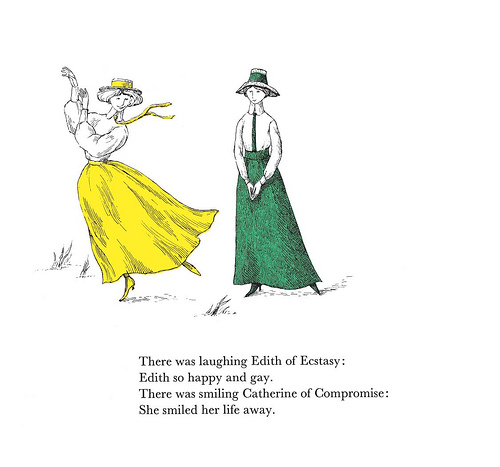
Time Out New York Kids‘ lyrical review of Three Ladies Beside the Sea by Edward Gorey and his emblazoned cohort, Rhoda Levine.


The International Tokyo Toy Show conjures up images of Asmovian defying robot, monsters (usually of the aquatic species), tooth-decayingly cute creatures and an array of insects. At least, that’s what I envisioned before braving the labyrinth train route to Tokyo Big Sight where this year’s International Tokyo Toy Show was held (July 15-18, 2010). The show did offer its fair share of creepy crawly beetle-mania with such companies as Megahouse; the proveyors of edible, gummy insects and Hexbug; creators of nanotech bugs with realistic pinching action.

Pullip Dolls from Groove, Inc.
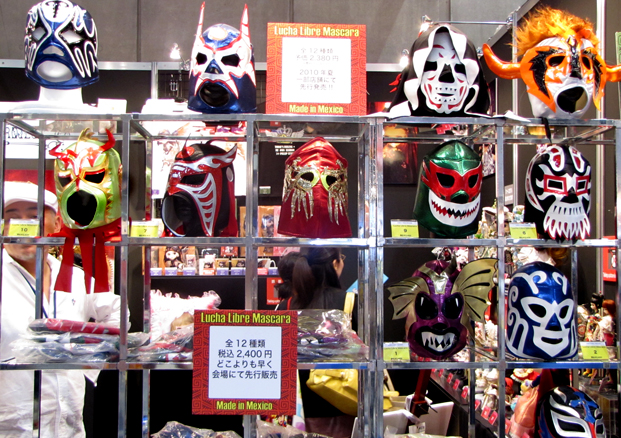
Lucha Libre Masks-Groove, Inc.
Although there were a few companies that caught my attention, the show sadly lacked the pop culture cornucopia that I was hoping for. The show was mainly dominated by such toy giants as Bandai and Lego. There was also steady stream of bags amongst the swarms of people bearing the logo for Hot Toys. Hot Toys sells fully articulated and extremely detailed action figures of everything from current icons such as Iron Man and Predator to generic and inexplicably nude male figures labeled by ethniticity. The figure labeled “African American Male” was easily modeled after Obama (complete with a plastic hardpack and politician death stare).

JewelPet Cycle

Duck Commanders
I did find however find a booth that stood out from the towering giants. The company is called Groove, Inc. Groove, Inc. has assimilated the defunct Jun Planning which was known for its wide-eyed collection of Pullip Dolls. Continuing the line of Pullip Dolls and with apparent knack for design sensible trends, Groove, Inc. displayed its latest line of Steampunk inspired dolls accented by the accessory craze of Alice in Wonderland.
1 Comments on International Tokyo Toy Show 2010, last added: 7/25/2010
The International Tokyo Toy Show conjures up images of Asmovian defying robot, monsters (usually of the aquatic species), tooth-decayingly cute creatures and an array of insects. At least, that’s what I envisioned before braving the labyrinth train route to Tokyo Big Sight where this year’s International Tokyo Toy Show was held (July 15-18, 2010). The show did offer its fair share of creepy crawly beetle-mania with such companies as Megahouse; the proveyors of edible, gummy insects and Hexbug; creators of nanotech bugs with realistic pinching action.

Pullip Dolls from Groove, Inc.
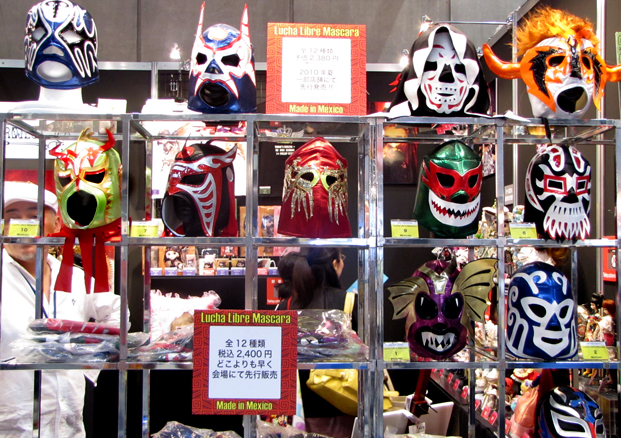
Lucha Libre Masks-Groove, Inc.
Although there were a few companies that caught my attention, the show sadly lacked the pop culture cornucopia that I was hoping for. The show was mainly dominated by such toy giants as Bandai and Lego. There was also steady stream of bags amongst the swarms of people bearing the logo for Hot Toys. Hot Toys sells fully articulated and extremely detailed action figures of everything from current icons such as Iron Man and Predator to generic and inexplicably nude male figures labeled by ethniticity. The figure labeled “African American Male” was easily modeled after Obama (complete with a plastic hardpack and politician death stare).
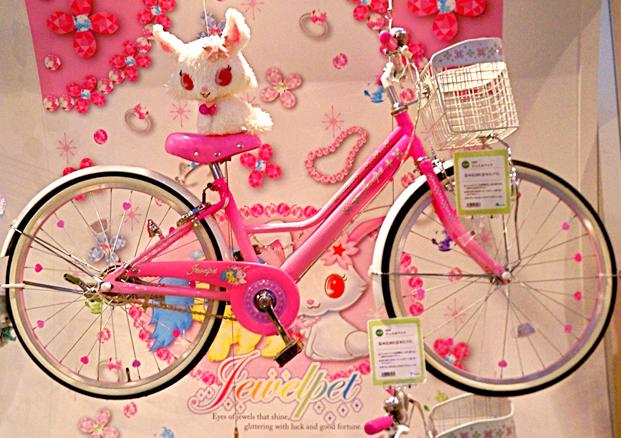
JewelPet Cycle

Duck Commanders
I did find however find a booth that stood out from the towering giants. The company is called Groove, Inc. Groove, Inc. has assimilated the defunct Jun Planning which was known for its wide-eyed collection of Pullip Dolls. Continuing the line of Pullip Dolls and with apparent knack for design sensible trends, Groove, Inc. displayed its latest line of Steampunk inspired dolls accented by the accessory craze of Alice in Wonderland.

Hello Kitty Harem
Although, the toys at the Tokyo Toy Show were more Toys ‘r Us than Kid Robot, I was grateful that Japan hadn’t given up on robots and bugs afterall.



Artist Konatsu brushes upon both the past and present of Japanese art. Creatures rendered in marshmallowly forms prance around in folkloric landscapes of spidery trees and peep outside of thatched houses. Each print is brought to life against a backdrop of scroll-esque delicacy.
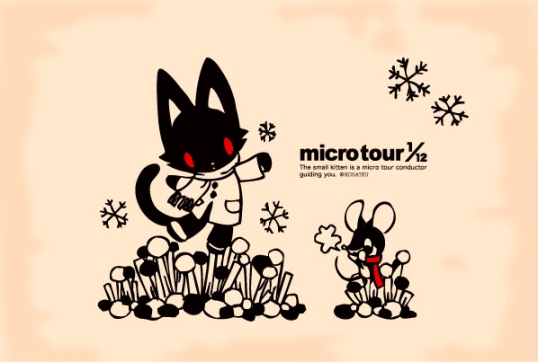
I discovered Konatsu’s work at a mind-spinning store in Shinjuku called Pop Space (be forewarned-it’s not the easiest site to navigate). I happily picked up several postcards of her art from amongst a twirling rack of design cacophony. Pop Space also has a large scale mural done by Konatsu which depicts dinosaur disguised creatures that seemed to be plucked from prehistoric times and curiously lost in an Edo period of cuteness.
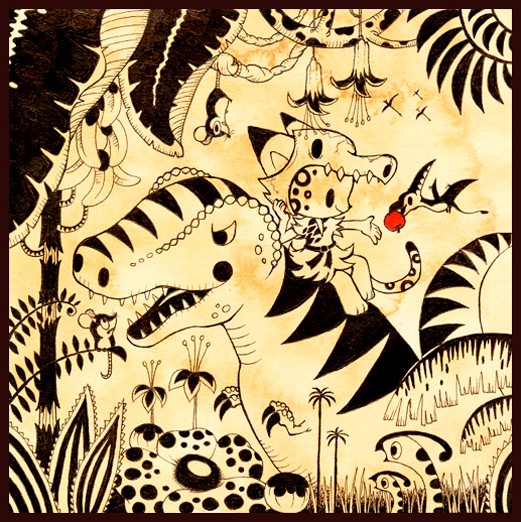








Artist Konatsu brushes upon both the past and present of Japanese art. Creatures rendered in marshmallowly forms prance around in folkloric landscapes of spidery trees and peep outside of thatched houses. Each print is brought to life against a backdrop of scroll-esque delicacy.
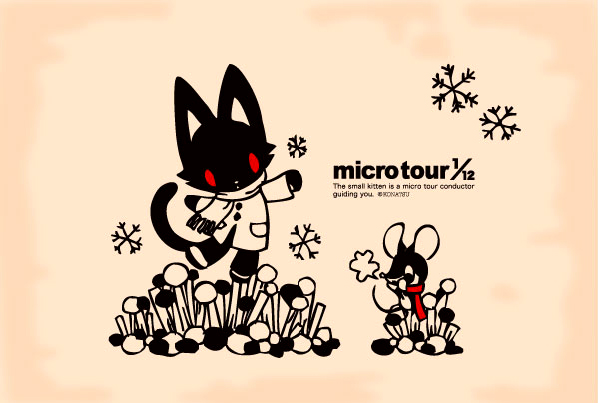
I discovered Konatsu’s work at a mind-spinning store in Shinjuku called Pop Space (be forewarned-it’s not the easiest site to navigate). I happily picked up several postcards of her art from amongst a twirling rack of design cacophony. Pop Space also has a large scale mural done by Konatsu which depicts dinosaur disguised creatures that seemed to be plucked from prehistoric times and curiously lost in an Edo period of cuteness.




By:
rubywinkle,
on 5/30/2010
Blog:
The Ruby Winkle Review: Children's Books, Illustration and More!
(
Login to Add to MyJacketFlap)
JacketFlap tags:
library,
Reviews,
folklore,
fairytales,
Rebecca Dautremer,
meghan killeen,
French animation,
French illustrator,
The Secret Lives of Princesses,
Tai-Marc Le Thanh,
Babayaga,
Kerity: La Maison des Contes,
Eleanor's Secret,
Dominique Monféry,
Noela Mari,
Add a tag
 The art of French illustrator Rebecca Dautremer is like stepping through paper windows into miniature, rouge accented worlds of wonder. Dautremer has a legacy as an illustrator with a soft spot for fairytales touched by a sense of humor. She has worked on such children’s book titles as The Secret Lives of Princesses and collaborated with her husband, author Taï-Marc Le Thanh, on an adaptation of the notorious child-napping ogress of Slavic-lore, Babayaga. Dautremer has recently brought her design talents and also her love of folklore to life in the animated salute to storytelling entitled Kerity: La Maison des Contes (the English title is Eleanor’s Secret). Kerity, directed by Dominique Monféry, is about a young boy named Nathaniel who inherits his aunt’s library and the real life stories contained within the books. The caveat to this imaginative inheritance is Nathaniel’s illiteracy which is relentlessly mocked by his bratty sister and the impending collapse of his aunt’s dilapidated house. Despite Rebecca Dautremer’s renown, I sadly found very little mention of her in the U.S. aside from the incongruously English dubbed version of Kerity (the sister sounds like a digitized Brit and the parents seemed stocked with awkward dialogue). Thank you Noela for your introduction!
The art of French illustrator Rebecca Dautremer is like stepping through paper windows into miniature, rouge accented worlds of wonder. Dautremer has a legacy as an illustrator with a soft spot for fairytales touched by a sense of humor. She has worked on such children’s book titles as The Secret Lives of Princesses and collaborated with her husband, author Taï-Marc Le Thanh, on an adaptation of the notorious child-napping ogress of Slavic-lore, Babayaga. Dautremer has recently brought her design talents and also her love of folklore to life in the animated salute to storytelling entitled Kerity: La Maison des Contes (the English title is Eleanor’s Secret). Kerity, directed by Dominique Monféry, is about a young boy named Nathaniel who inherits his aunt’s library and the real life stories contained within the books. The caveat to this imaginative inheritance is Nathaniel’s illiteracy which is relentlessly mocked by his bratty sister and the impending collapse of his aunt’s dilapidated house. Despite Rebecca Dautremer’s renown, I sadly found very little mention of her in the U.S. aside from the incongruously English dubbed version of Kerity (the sister sounds like a digitized Brit and the parents seemed stocked with awkward dialogue). Thank you Noela for your introduction!




By:
rubywinkle,
on 5/20/2010
Blog:
The Ruby Winkle Review: Children's Books, Illustration and More!
(
Login to Add to MyJacketFlap)
JacketFlap tags:
Uncategorized,
meghan killeen,
Optivion,
Design Festa,
Tokyo Big Sight,
Chotashiki,
FeeBee,
Japanese pop culture,
Jason Raish,
John Hathaway,
Kamaty Moon,
Kusukusu,
Naeshico Rin,
Savoya,
Takokara,
Tama,
Vol. 31,
Add a tag
Imagine a world where Japan’s artistic eccentricities of the past, the future and the surreally subversive come together for a visual tea party. Welcome to Design Festa! This past weekend, I attended Design Festa’s 31st event (its inception was held in 1994). Upon entering the illuminati tower that is Tokyo Big Sight (back again!), I was immediately greeted by three floors of sprawling artist booths creatively customized to represent everything from an anime metropolis cutout to live miniature Kabuki theatre.
As I walked down each elaborately adorned aisle, I noticed the artistic touches that made this event uniquely and distinctly Japanese despite the event’s international umbrella. I saw prints depicting lonely eyed Japanese schoolgirls strumming guitars blissfully unaware of the Hokusai tsunami behind them. A few booths away, I noticed a cluster of people illuminated by something that resembled a fluorescently lit medicine cabinet. A few of the viewers held tiny vials in their hand. A closer inspection revealed that the specimens in the vials were the color-injected bones of fossilized fish. As I continued to walk through the masses of Victorian maid outfits and furry mascots, I found a booth that was eerily unattended. It showcased tiny, abandoned buildings which I suspected were the flea-circus equivalent of a haunted house. As I declined the offer to receive a cosmetic scab and stitches, I stumbled upon a runway of cherubic Japanese children doing a synchronized dance followed by a Blade Runner inspired fashion show.
Design Festa is the rabbit hole of emergent Japanese artists who push each medium be it wooden robots or water-colored witches. Pick your pop culture poison. The next Design Festa is scheduled for November 2010. This time, I think I’ll see what happens when we step onto the other side of the looking glass booth.
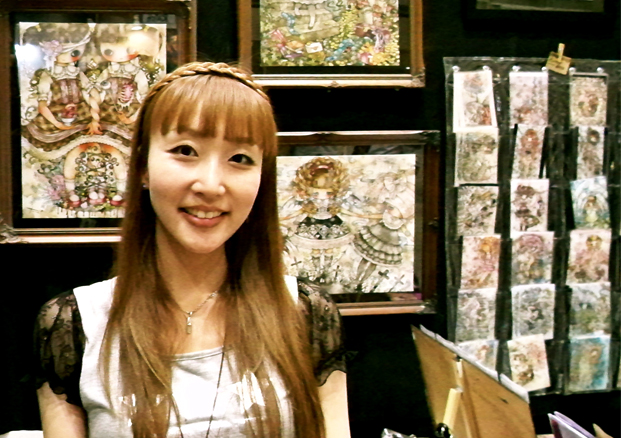
Illustrator Tama
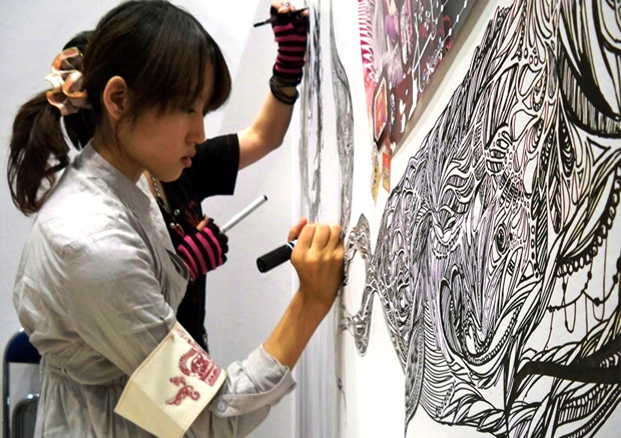
Whale Sketch
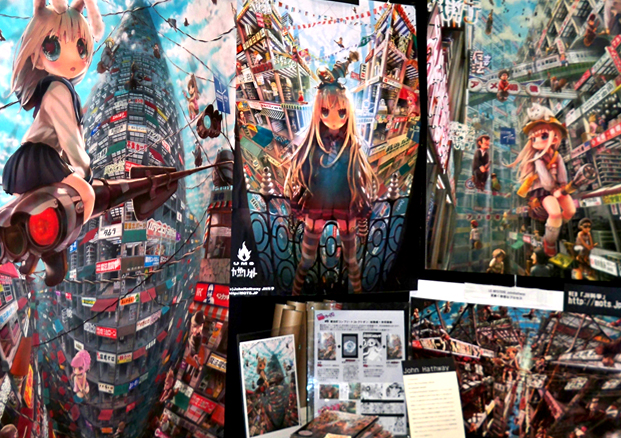
John Hathaway

Robots

Artist Savoya
Imagine a world where Japan’s artistic eccentricities of the past, the future and the surreally subversive come together for a visual tea party. Welcome to Design Festa! This past weekend, I attended Design Festa’s 31st event (its inception was held in 1994). Upon entering the illuminati tower that is Tokyo Big Sight (back again!), I was immediately greeted by three floors of sprawling artist booths creatively customized to represent everything from an anime metropolis cutout to live miniature Kabuki theatre.
As I walked down each elaborately adorned aisle, I noticed the artistic touches that made this event uniquely and distinctly Japanese despite the event’s international umbrella. I saw prints depicting lonely eyed Japanese schoolgirls strumming guitars blissfully unaware of the Hokusai tsunami behind them. A few booths away, I noticed a cluster of people illuminated by something that resembled a fluorescently lit medicine cabinet. A few of the viewers held tiny vials in their hand. A closer inspection revealed that the specimens in the vials were the color-injected bones of fossilized fish. As I continued to walk through the masses of Victorian maid outfits and furry mascots, I found a booth that was eerily unattended. It showcased tiny, abandoned buildings which I suspected were the flea-circus equivalent of a haunted house. As I declined the offer to receive a cosmetic scab and stitches, I stumbled upon a runway of cherubic Japanese children doing a synchronized dance followed by a Blade Runner inspired fashion show.
Design Festa is the rabbit hole of emergent Japanese artists who push each medium be it wooden robots or water-colored witches. Pick your pop culture poison. The next Design Festa is scheduled for November 2010. This time, I think I’ll see what happens when we step onto the other side of the looking glass booth.
*Some of the photos below link to websites. So clicky-away!

Illustrator Tama

Whale Sketch

John Hathaway

Robots
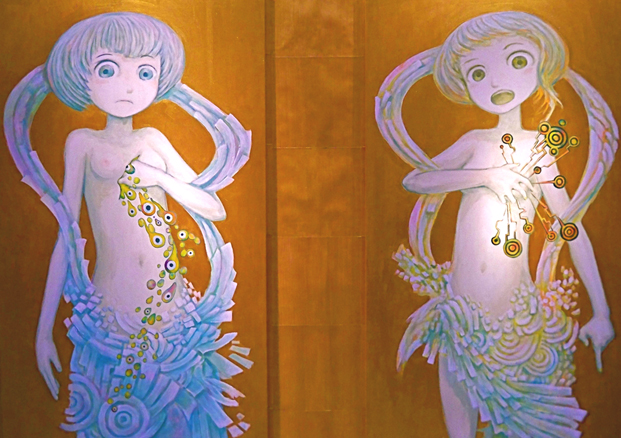
Artist Savoya
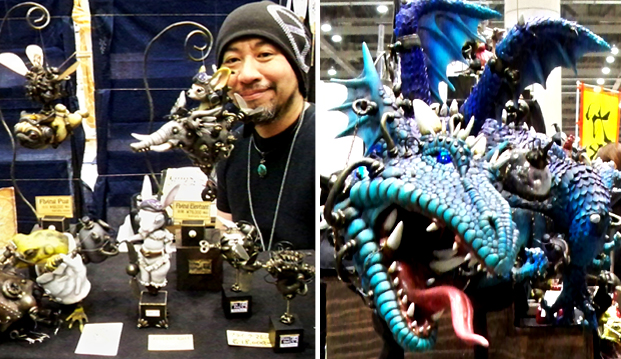
Kamaty Moon

Takokara
Photos: Optivion & Meghan



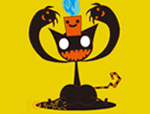


By:
rubywinkle,
on 5/17/2010
Blog:
The Ruby Winkle Review: Children's Books, Illustration and More!
(
Login to Add to MyJacketFlap)
JacketFlap tags:
john and wendy,
lonely star,
Periwinkle and the Twirly,
periwinkle smith,
Periwinkle Smith and the Faraway Star,
Price Stern Sloan,
Whirly Tutu,
Reviews,
telescope,
Penguin Books,
meghan killeen,
Add a tag
 The inventive Ms. Periwinkle Smith has returned in her second and latest adventure, Periwinkle Smith and the Faraway Star by John and Wendy. Still twirling and whirling in her trademark tutu, the punky and pirouetting Ms. Periwinkle sets her sights on a golden telescope. Through her looking glass, Periwinkle spies birds, fish and even villainous bathtub pirates yet it’s a lonely star in the sky that captures Periwinkle’s eye and inevitably, her heart. Determined to befriend the lonely star, Periwinkle dreams up different ways to send her message “up, up, up”. After a few inspired efforts, Periwinkle and her trusty tabby find an enlightened form of delivery that brings the faraway star close to home.
The inventive Ms. Periwinkle Smith has returned in her second and latest adventure, Periwinkle Smith and the Faraway Star by John and Wendy. Still twirling and whirling in her trademark tutu, the punky and pirouetting Ms. Periwinkle sets her sights on a golden telescope. Through her looking glass, Periwinkle spies birds, fish and even villainous bathtub pirates yet it’s a lonely star in the sky that captures Periwinkle’s eye and inevitably, her heart. Determined to befriend the lonely star, Periwinkle dreams up different ways to send her message “up, up, up”. After a few inspired efforts, Periwinkle and her trusty tabby find an enlightened form of delivery that brings the faraway star close to home.
Periwinkle Smith is a strong and spirited girl distinguished by her signature bow, blue hair and paint-splattered tutu. Ms. Smith is equal parts childhood curiosity and rock n’ roll DIY-namics. John and Wendy have created a diminutively cute character with a large presence that continues to demonstrate infectious enthusiasm and ingenuity. Always armed with a solution up her stripey sleeve, Ms. Smith proves that no adventure or dream is too big. I’m convinced that her adventures have only just begun. So, where to next, Periwinkle?








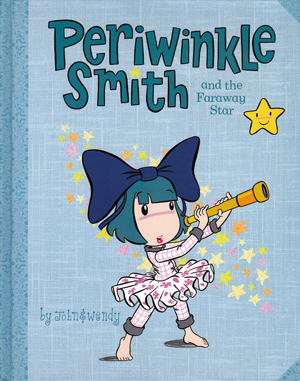 The inventive Ms. Periwinkle Smith has returned in her second and latest adventure, Periwinkle Smith and the Faraway Star by John and Wendy. Still twirling and whirling in her trademark tutu, the punky and pirouetting Ms. Periwinkle sets her sights on a golden telescope. Through her looking glass, Periwinkle spies birds, fish and even villainous bathtub pirates yet it’s a lonely star in the sky that captures Periwinkle’s eye and inevitably, her heart. Determined to befriend the lonely star, Periwinkle dreams up different ways to send her message “up, up, up”. After a few inspired efforts, Periwinkle and her trusty tabby find an enlightened form of delivery that brings the faraway star close to home.
The inventive Ms. Periwinkle Smith has returned in her second and latest adventure, Periwinkle Smith and the Faraway Star by John and Wendy. Still twirling and whirling in her trademark tutu, the punky and pirouetting Ms. Periwinkle sets her sights on a golden telescope. Through her looking glass, Periwinkle spies birds, fish and even villainous bathtub pirates yet it’s a lonely star in the sky that captures Periwinkle’s eye and inevitably, her heart. Determined to befriend the lonely star, Periwinkle dreams up different ways to send her message “up, up, up”. After a few inspired efforts, Periwinkle and her trusty tabby find an enlightened form of delivery that brings the faraway star close to home.
Periwinkle Smith is a strong and spirited girl distinguished by her signature bow, blue hair and paint-splattered tutu. Ms. Smith is equal parts childhood curiosity and rock n’ roll DIY-namics. John and Wendy have created a diminutively cute character with a large presence that continues to demonstrate infectious enthusiasm and ingenuity. Always armed with a solution up her stripey sleeve, Ms. Smith proves that no adventure or dream is too big. I’m convinced that her adventures have only just begun. So, where to next, Periwinkle?
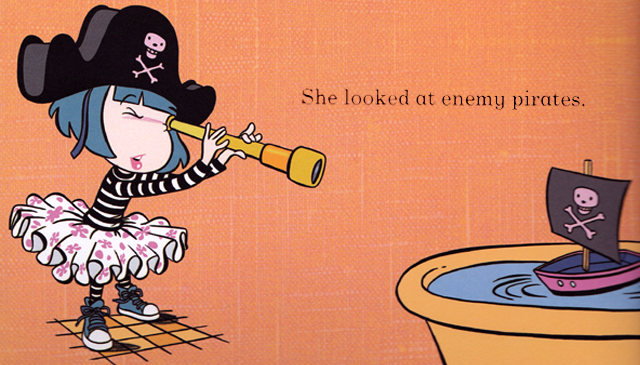




If candy was a deliciously animate object, it would manifest itself as Tokyo Disney. The resort’s sprawling backdrop strikes you the moment you step out of the train station. Each facade is made up of an entire palette of pastels seemingly spun from some sort of giant, cocoon of cotton candy. Tokyo Disney is the Willy Wonka of architecture and design.
Optivion and I walked through the gates of Tokyo Disney and were immediately thrown into a headspin. The commercial-esque umbrella stroll of Mary Poppins trailed by a group of young girls wearing Mickey ears on our right. A brilliantly yellow topiary sculpture of Mickey Mouse on our left. The “Something Wicked This Way Comes” twirl of a nearby carousel. I even started to notice some of the fellow tourists. Out of the corner of my eye, I noticed a furtive figure dressed in an enormous Safari hat drowning in a puffy ascot and prop-sized camera. My first thought was, “how wholesomely cute”. It was a thought that frequently came to mind whenever I saw a costumed Japanese person. The Japanese fondness for accessories is astounding. If it’s time to clean-on goes the matching bandana and apron. If a new road needs to be laid-on goes the blue uniform with matching yellow shoes and hard hat. In a sense, the Japanese people had become something out of a Richard Scarry children’s book.
It wasn’t until Optivion and I were drawn with headlight hypnotism to the Alice in Wonderland sculptures that I noticed that the same “cute” camera-wielding tourist was now a very tired and nervous Disney employee forced to conjole smiles out of serious fun goers.

Optivion and I continued to walk pass vendors selling themed variations of cuteness and ambigiously Westernized food stuff (read greasey ham hocks). The Disney theme parks are by nature exceptionally surreal in incarnating movie magic however Tokyo Disney took it one step further by devoting a whole month to Alice in Wonderland. There was even a spiral-spinning (you guessed it) stomach-clutching tea cup ride. Awestruck, Optivion and I stared up at a Scissorhand-sized heart-shaped topiary gate that enclosed the entrance of the “Queen of Hearts” restaurant. The gimmicky-ness of the restaurant immediately dissolved under the incredible attention to detail. Lured by the life-sized card soldiers and the waitress attired in an argyle chef hat and apron (“wholesomely cute”), Optivion and I resigned oursevlves to touristly gluttony and sat down for a meal of heart-shaped cutlets served with Mickey Mouse cutlery.
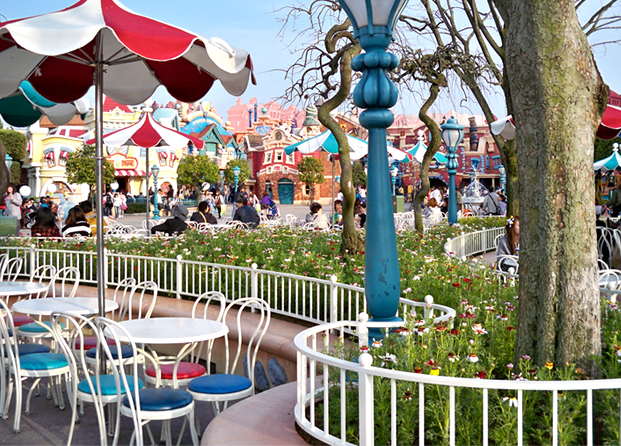
Next, we decided to wait for the large parade that was scheduled that day. We thought it would be a small platoon of smiling mascots and glittery floats on wheels. We sat down and surprisingly, secured first row seats near a Medieval sized door where the parade was expected to start.
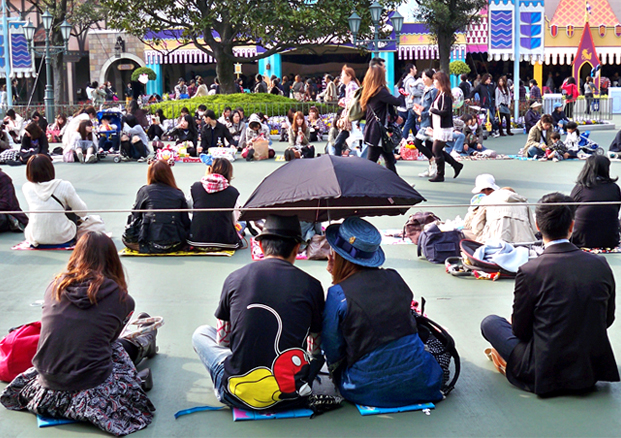 0 Comments on Tokyo Disney-The Wa of Cute as of 1/1/1900
0 Comments on Tokyo Disney-The Wa of Cute as of 1/1/1900

If candy was a deliciously animate object, it would manifest itself as Tokyo Disney. The resort’s sprawling backdrop strikes you the moment you step out of the train station. Each facade is made up of an entire palette of pastels seemingly spun from some sort of giant, cocoon of cotton candy. Tokyo Disney is the Willy Wonka of architecture and design.
Optivion and I walked through the gates of Tokyo Disney and were immediately thrown into a headspin. The commercial-esque umbrella stroll of Mary Poppins trailed by a group of young girls wearing Mickey ears on our right. A brilliantly yellow topiary sculpture of Mickey Mouse on our left. The “Something Wicked This Way Comes” twirl of a nearby carousel. I even started to notice some of the fellow tourists. Out of the corner of my eye, I noticed a furtive figure dressed in an enormous Safari hat drowning in a puffy ascot and prop-sized camera. My first thought was, “how wholesomely cute”. It was a thought that frequently came to mind whenever I saw a costumed Japanese person. The Japanese fondness for accessories is astounding. If it’s time to clean-on goes the matching bandana and apron. If a new road needs to be laid-on goes the blue uniform with matching yellow shoes and hard hat. In a sense, the Japanese people had become something out of a Richard Scarry children’s book.
It wasn’t until Optivion and I were drawn with headlight hypnotism to the Alice in Wonderland sculptures that I noticed that the same “cute” camera-wielding tourist was now a very tired and nervous Disney employee forced to conjole smiles out of serious fun goers.

Optivion and I continued to walk pass vendors selling themed variations of cuteness and ambigiously Westernized food stuff (read greasey ham hocks). The Disney theme parks are by nature exceptionally surreal in incarnating movie magic however Tokyo Disney took it one step further by devoting a whole month to Alice in Wonderland. There was even a spiral-spinning (you guessed it) stomach-clutching tea cup ride. Awestruck, Optivion and I stared up at a Scissorhand-sized heart-shaped topiary gate that enclosed the entrance of the “Queen of Hearts” restaurant. The gimmicky-ness of the restaurant immediately dissolved under the incredible attention to detail. Lured by the life-sized card soldiers and the waitress attired in an argyle chef hat and apron (“wholesomely cute”), Optivion and I resigned oursevlves to touristly gluttony and sat down for a meal of heart-shaped cutlets served with Mickey Mouse cutlery.

Next, we decided to wait for the large parade that was scheduled that day. We thought it would be a small platoon of smiling mascots and glittery floats on wheels. We sat down and surprisingly, secured first row seats near a Medieval sized door where the parade was expected to start.

Suddenly, the green door burst open like an animated pinnata of colors. For the first time, I think my jaw literally dropped.
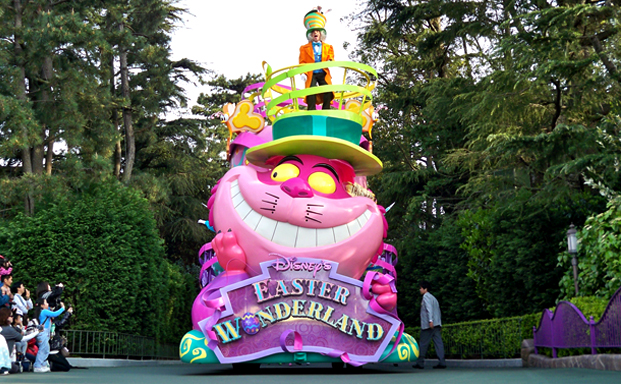

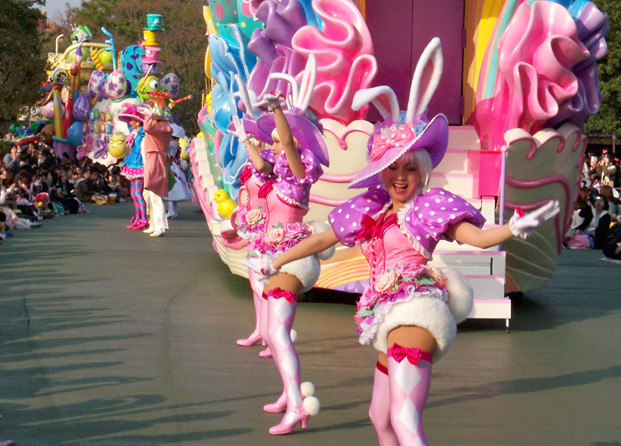
Afterwards, we rode several rides which seemed like a strange anomaly of new-old. The rides had a certain 1950′s sense of simplicity. The Haunted Mansion had flickering candles and equally flickery holograms while The Snow White ride was like a spooky picnic on a rickety go-cart. Although the park seemed a bit dated compared to the leviathan that is Walt Disney Florida, everything still retained a coat of newness.
It is easy to say that things seem better (or worse) when you’re in a foreign country. By default, everything takes on a filter of comparison and rarely is seen as what it is. Although, Tokyo Disney seemed somehow quieter and more peaceful (there was a lack of obnoxious families screaming at their children or at least it was concealed by the more whisperous tones of Japanese), it wasn’t that much more different than any other Disney resort. Tokyo Disney wasn’t bigger or cuter or superior. It was its own wonderful entity.
The last ride that we went on was “It’s a Small World” which is made up of a large scale diorama of kewpie looking dolls representing each country except for the U.S. (they could have at least thrown in a cowboy or tiny SUV to represent). It was, well, wholesomely cute. It harkened back to a time when things were enough. When the rides didn’t have to be gimmickier or scarier or more advanced. Tokyo Disney reminded me that each world, no matter how brightly you paint it, is linked by a small “time” after all.


By:
rubywinkle,
on 3/31/2010
Blog:
The Ruby Winkle Review: Children's Books, Illustration and More!
(
Login to Add to MyJacketFlap)
JacketFlap tags:
Uncategorized,
animation,
Anime,
NY Comic Con,
San Diego Comic Con,
Sonic,
WonderCon,
meghan killeen,
Optivion,
Hangry Angry,
Hashiru Ueda,
Michihisa Ohrui,
Ohrys Bird,
stop-action,
Takorasu,
The Artist Army,
Tokyo International Anime Festival,
Woodpecker Films,
yeoypawka,
Add a tag
Anime Fest. The event conjures up images of thirteen year-old cosplayers with styrofoam swords and swag laden bags hypnotized by the polarity of sexpot dolls and kawaii plushies. As the Tokyo International Anime Festival approached, I thought back to previous convention giants-San Diego Comic Con, WonderCon (based in San Francisco) and the emerging NY Comic Con. I recalled swarms of people-some in elaborate costumes while others wore hand-scrawled indie t-shirts-all huddled together in wide-eyed unison. Carnivorous consumers gathered up gimmicky promos and fawned over the flirtatious hawking of vendors. Novice artists, armed with black-handled portfolios, nervously approached such creative monoliths as Dark Horse and DC Comics for an approving nod. In essence, the U.S. comic (and anime) conventions were a seaport-esque mecca of subculture and entertainment where artists vied for the attention of a cash-pouring and adoring audience.

Optivion and I walked up the Tokyo Big Sight where the Tokyo International Anime Festival was being held. We looked up in awe at the illuminati-shaped building and excitedly went inside, anticipating hordes of cosplayers and random hybrids of Japanese kookiness like samurai robots or toilet seat hats (maybe?). We glided along the people mover like moon-eyed characters in a Spike Jonze video until we reached the main entrance. As we rode the motorized sloth towards the festival, I noticed that in lieu of colorful kids there appeared to be more men in business suits and middle-aged families. It was then that it hit me just how unbiquitious anime was in Japan. An anime festival isn’t a subculture event. It is the culture. Manga was just as likely to be in a salaryman’s briefcase as it was a ten-year boy’s backpack.

We entered the main room and gazed up at an inflated Pikacho and Totoro grinning down like rolly-polly zepplins. After stopping at a sadly scarce Studio Ghibli booth (just a shelf full of a few books for sale), we ran into an independent artist by the name of Sonic who silently held a sign advertising an artist collective called The Artist Army. We oggled over his Tim Burton-esque dolls and after giving several language-impaired thumbs-ups, we shyly asked for a photo.

Look! The sign works. We then passed by an incredible candy-c
By:
rubywinkle,
on 3/31/2010
Blog:
The Ruby Winkle Review: Children's Books, Illustration and More!
(
Login to Add to MyJacketFlap)
JacketFlap tags:
Uncategorized,
animation,
Anime,
NY Comic Con,
San Diego Comic Con,
Sonic,
WonderCon,
meghan killeen,
Optivion,
Hangry Angry,
Hashiru Ueda,
Michihisa Ohrui,
Ohrys Bird,
stop-action,
Takorasu,
The Artist Army,
Tokyo International Anime Festival,
Woodpecker Films,
yeoypawka,
Add a tag
Anime Fest. The event conjures up images of thirteen year-old cosplayers with styrofoam swords and swag laden bags hypnotized by the polarity of sexpot dolls and kawaii plushies. As the Tokyo International Anime Fair approached, I thought back to previous convention giants-San Diego Comic Con, WonderCon (based in San Francisco) and the emerging NY Comic Con. I recalled swarms of people-some in elaborate costumes while others wore hand-scrawled indie t-shirts-all huddled together in wide-eyed unison. Carnivorous consumers gathered up gimmicky promos and fawned over the flirtatious hawking of vendors. Novice artists, armed with black-handled portfolios, nervously approached such creative monoliths as Dark Horse and DC Comics for an approving nod. In essence, the U.S. comic (and anime) conventions were a seaport-esque mecca of subculture and entertainment where artists vied for the attention of a cash-pouring and adoring audience.

Optivion and I walked up the Tokyo Big Sight where the Tokyo International Anime Fair was being held. We looked up in awe at the illuminati-shaped building and excitedly went inside, anticipating hordes of cosplayers and random hybrids of Japanese kookiness like samurai robots or toilet seat hats (maybe?). We glided along the people mover like moon-eyed characters in a Spike Jonze video until we reached the main entrance. As we rode the motorized sloth towards the festival, I noticed that in lieu of colorful kids there appeared to be more men in business suits and middle-aged families. It was then that it hit me just how unbiquitious anime was in Japan. An anime festival isn’t a subculture event. It is the culture. Manga was just as likely to be in a salaryman’s briefcase as it was a ten-year boy’s backpack.

We entered the main room and gazed up at an inflated Pikachu and Totoro grinning down like rolly-polly zepplins. After stopping at a sadly scarce Studio Ghibli booth (just a shelf full of a few books for sale), we ran into an independent artist by the name of Sonic who silently held a sign advertising an artist collective called The Artist Army. We oggled over his Tim Burton-esque dolls and after giving several language-impaired thumbs-ups, we shyly asked for a photo.

Look! The sign works. We then pa
Anime Fest. The event conjures up images of thirteen year-old cosplayers with styrofoam swords and swag laden bags hypnotized by the polarity of sexpot dolls and kawaii plushies. As the Tokyo International Anime Fair approached, I thought back to previous convention giants-San Diego Comic Con, WonderCon (based in San Francisco) and the emerging NY Comic Con. I recalled swarms of people-some in elaborate costumes while others wore hand-scrawled indie t-shirts-all huddled together in wide-eyed unison. Carnivorous consumers gathered up gimmicky promos and fawned over the flirtatious hawking of vendors. Novice artists, armed with black-handled portfolios, nervously approached such creative monoliths as Dark Horse and DC Comics for an approving nod. In essence, the U.S. comic (and anime) conventions were a seaport-esque mecca of subculture and entertainment where artists vied for the attention of a cash-pouring and adoring audience.

Optivion and I walked up the Tokyo Big Sight where the Tokyo International Anime Fair was being held. We looked up in awe at the illuminati-shaped building and excitedly went inside, anticipating hordes of cosplayers and random hybrids of Japanese kookiness like samurai robots or toilet seat hats (maybe?). We glided along the people mover like moon-eyed characters in a Spike Jonze video until we reached the main entrance. As we rode the motorized sloth towards the festival, I noticed that in lieu of colorful kids there appeared to be more men in business suits and middle-aged families. It was then that it hit me just how unbiquitious anime was in Japan. An anime festival isn’t a subculture event. It is the culture. Manga was just as likely to be in a salaryman’s briefcase as it was a ten-year boy’s backpack.
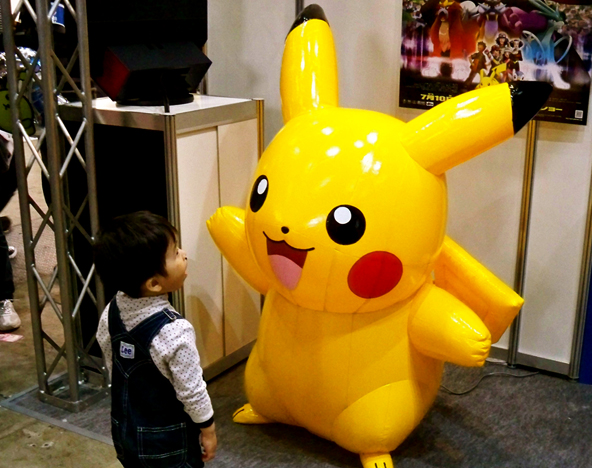
We entered the main room and gazed up at an inflated Pikachu and Totoro grinning down like rolly-polly zepplins. After stopping at a sadly scarce Studio Ghibli booth (just a shelf full of a few books for sale), we ran into an independent artist by the name of Sonic who silently held a sign advertising an artist collective called The Artist Army. We oggled over his Tim Burton-esque dolls and after giving several language-impaired thumbs-ups, we shyly asked for a photo.

Look! The sign works. We then passed by an incredible candy-colored display for the impishly cute yeoypawka.

After wandering through aisles of towering booths (one actually resembled a traditional Japanese house), we came across the glorious “Creator’s World” section full of amazing independent animators (mostly stop-action) and artists. We first happened upon the inky Steampunk illustrations of artist Takorasu. We were then drawn to the clever work of animation duo “Woodpecker” . Their booth was adorned like a delirious hobbyists’ attic-full of miniature houses and trees. Woodpecker’s films are interestingly bizarre and strangely comical stop-action scenarios.
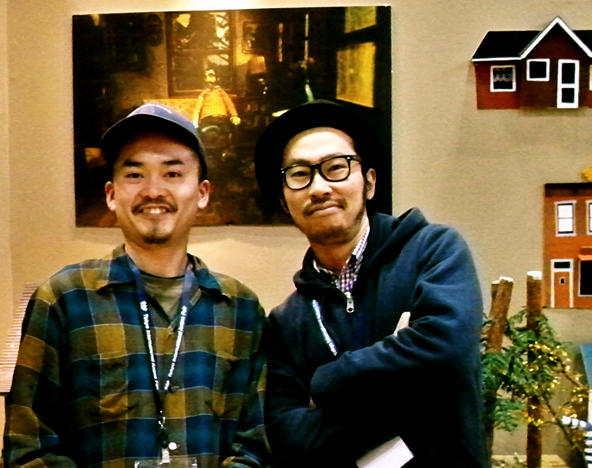
Woodpecker’s friendly booth neighbor, artist Michihisa Ohrui, caught our attention with his pink wall and wonderfully handcrafted props. Michihisa is one half of the fantastically fun animation duo (Hashiru Ueda is the other half), Ohrys Bird. Again, after giving a flurry of language limited thumbs-ups, Optivion and I cajoled Michihisa into a photo.

The Tokyo International Anime Fair offered very little purchasable paraphenalia for the consumer crazed and seemed devoid of scrutinizing scouts for eager new artists. It also had few ambling mascots and nary a cardboard clad cosplayer was in sight (there were very few people in costume in general save a few scantily cladded girls and the Goth-ish Hello Kitty mascot for the clothing and accessory line, Hangry & Angry-see the photo below).

It did however have an array of some of the most original and painfully stunning artwork that I have seen in a long time. To see more “Creative World” independent artists, please click on the thumbnails below.
*All photos by Optivion






My book review for Mathilda and the Orange Balloon (by Randall de Sève, Illustrated by Jen Corace) posted in
Time Out New York Kids.



By:
rubywinkle,
on 2/18/2010
Blog:
The Ruby Winkle Review: Children's Books, Illustration and More!
(
Login to Add to MyJacketFlap)
JacketFlap tags:
Interviews,
skeleton,
fashion,
bones,
accessories,
Inc.,
Hot Topic,
Skelanimals,
Art Impressions,
Cingy Bailey,
Milky Way and the Galaxy Girls,
Wittle Bittle,
Add a tag
 Skelanimals turns cute inside out with its skeleton crew of characters. The Skelanimals have gone from bone bearing graphics and plush dolls to a full blown fashion and accessory line. Stripped of skin but full of heart, each animal is characterized by its doe-eyed skull and black and white skeleton suit. Skelanimals is licensed by Art Impressions, Inc. based in Calabasas, Caifornia. Art Impressions, Inc. is also the mastermind behind the space-age, girl-power troupe, “Milk Way and the Galaxy Girls” and the kawaii brigade, “Wittle Bittle“. Cindy Bailey, CEO of Art Impressions, Inc. reveals the spirit behind the Skelanimals and explains why we can’t stop being haunted by them.
Skelanimals turns cute inside out with its skeleton crew of characters. The Skelanimals have gone from bone bearing graphics and plush dolls to a full blown fashion and accessory line. Stripped of skin but full of heart, each animal is characterized by its doe-eyed skull and black and white skeleton suit. Skelanimals is licensed by Art Impressions, Inc. based in Calabasas, Caifornia. Art Impressions, Inc. is also the mastermind behind the space-age, girl-power troupe, “Milk Way and the Galaxy Girls” and the kawaii brigade, “Wittle Bittle“. Cindy Bailey, CEO of Art Impressions, Inc. reveals the spirit behind the Skelanimals and explains why we can’t stop being haunted by them.
1) What inspired the idea for Skelanimals?
Skelanimals first came to life as the subject of a self-published children’s book by Mitchell Bernal, an accomplished animation artist. To help his young son cope with the death of a family pet, Mitchell came up with the novel idea of portraying the afterlife in a humorous way, creating a collection of animals who met odd and untimely ends as a result of their own silly behavior. The book’s humorous poems about each animal really brought the characters to life and formed the starting point for our development of Skelanimals as a broader lifestyle brand.
2) Where and how did you first promote Skelanimals?
We launched Skelanimals plush, keychains and magnets at leading U.S. trend retailer Hot Topic in 2006. It was so popular that in 2007, Hot Topic featured full boutiques showcasing junior and young men’s apparel, loungewear, stuffed animals and plush backpacks, purses, totes, wallets, ID cases, keychains, bag charms, shoes, socks, hair accessories, fragrance and cosmetics, tinned candies, pins and patches, posters, throws, magnets and stickers.
It was so popular that in 2007, Hot Topic featured full boutiques showcasing junior and young men’s apparel, loungewear, stuffed animals and plush backpacks, purses, totes, wallets, ID cases, keychains, bag charms, shoes, socks, hair accessories, fragrance and cosmetics, tinned candies, pins and patches, posters, throws, magnets and stickers.
3) What do you think makes Skelanimals so popular?
One of the keys to Skelanimals’ popularity is its unique mixture of cuteness and edge. Skelanimals are light-hearted, cute and cuddly, never ghoulish or horrifying; irreverent but not offensive. As a result, the brand has been embraced by people of all ages, nationalities, and personalities…it hits that magical middle point between cute and cuddly and dark and edgy!
4) What is one of your favorite Skelanimals accessories?
The crystal studded panda necklace from PINKO in Italy!
5) Can you give advice to someone trying to get their intellectual property licensed?
The most important thing is to have a comprehensive collection of art including main characters, patterns, boarders, and main images. It helps to have a back stor
By:
rubywinkle,
on 2/1/2010
Blog:
The Ruby Winkle Review: Children's Books, Illustration and More!
(
Login to Add to MyJacketFlap)
JacketFlap tags:
arcade,
meghan killeen,
Optivion,
Don Quijote,
Uncategorized,
cute,
Japan,
videos,
evil,
kawaii,
Add a tag
There are no imaginary enemies here-only sickeningly cute adversaries dressed in animal skins of every combination smiling behind neon, plastic boxes. Don Quijote (spelled phonetically-its praise is sung throughout in a synthesized kid, choir chant-”la-la-lah-la-la-lah-Don-Key-Ho-tee”!) is a discount chain store in Japan that offers everything from racks of eyelashes to questionable junk food. Sadly, Don Quijote is more yellow, shoebox grade of architecture than the literary, looming windmill (although, I wouldn’t put it pass the Japanese to create a windmill structure adorned with a deranged mascot promoting buying bliss). It does, however, contain an epileptic arcade of flashing video games and fantastic vending machines of toys and plushies.
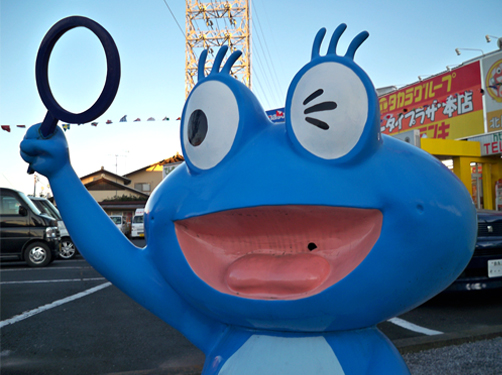

The vending machines house an array of creatures wearing pelt jumpsuits-rabbits are dressed in bear skins, bears are dressed in cat suits, etc. (the bi-curious species are both intriguiging and baffling). Everything within the arcade is dosed in cute. Stitched up dolls and bloody, clawed teddy bears are tempered by their adorable grins and cotton-colors. The arcade is manically brilliant and leaves one feeling a bit hopped up on Clockwork Orange stimulus overload. ”La-la-lah, la-la-lah….”
Thanks to Optivion for the photos (and for being the prince of prizes who won a solar-operated Maneki Neko waving statue).


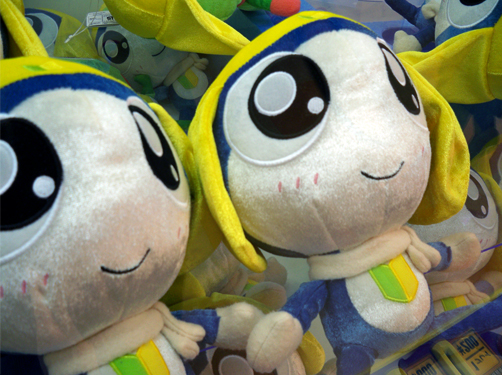
































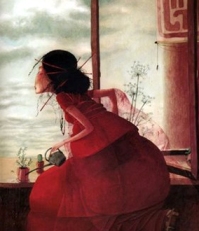
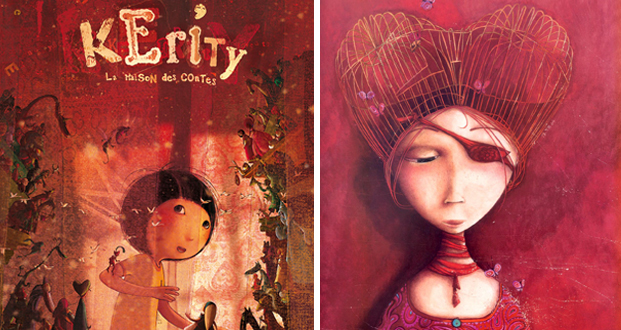































 0 Comments on Tokyo Disney-The Wa of Cute as of 1/1/1900
0 Comments on Tokyo Disney-The Wa of Cute as of 1/1/1900





















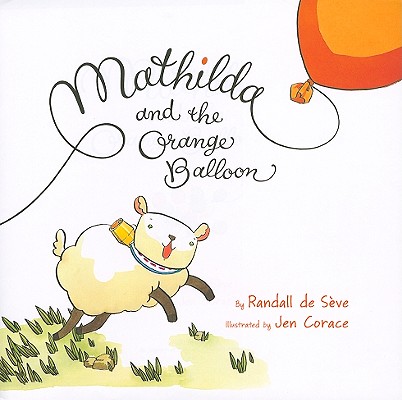













[...] Follow this link: International Tokyo Toy Show 2010 « The Ruby Winkle Review … [...]